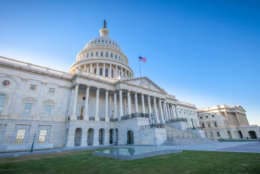TSP
-
When it comes to the safest investment option in their 401(k) plan, federal employees and retirees are split down the middle.
March 14, 2018 -
Senior Correspondent Mike Causey examines why feds sometimes have to tighten their belts for the first few months of retirement.
March 13, 2018 -
How long will the current bull market last and what should you do to prepare for the inevitable correction? Find out when certified financial planner Arthur Stein joins host Mike Causey on this week's Your Turn radio show. March 14, 2018
March 13, 2018 -
A huge number of federal workers are eligible to retire right now. That doesn’t mean they are going to leave. But they could.
March 12, 2018 -
What are the top reasons federal workers are retiring in droves? Is it fear and loathing of the Trump administration, changes in the stock market or something else?
March 06, 2018 -
Are federal workers retiring in larger numbers? Are we on the verge of the so-called retirement tsunami that experts have been predicting for years? Find out when Federal News Radio reporter Nicole Ogrysko joins host Mike Causey on this week's Your Turn. March 7, 2018
March 06, 2018 -
For the first time, total assets in the Thrift Savings Plan's C fund matched total assets in the G fund.
March 02, 2018 -
Many financial planners urge clients investing for retirement to take the long-view. For many investors that is easier said than done.
March 02, 2018 -
Returns from the Thrift Savings Plan took a sharp downturn in February, reflecting corrections in the stock market that made for a volatile month.
March 01, 2018 -
If somebody said your federal pension plan needs $152 billion in nip and tuck surgery, would you be alarmed? Maybe you should be, says Senior Correspondent Mike Causey.
February 27, 2018 -
Most people retiring from the federal government are at least as well off as their retired private-sector friends and neighbors, in many cases better off.
February 26, 2018 -
Nearly 120,000 callers spent 5 minutes or longer waiting for a Thrift Savings Plan call representative to pick up the phone last month, a metric that's well short of the TSP agency's customer service goals.
February 26, 2018 -
The fund where federal workers have most of their retirement nest egg returned 2.3 percent last year, while the fund where they have the least amount invested returned 25.4 percent. What's wrong with this picture?
February 22, 2018 -
Did the recent stock market nosedive send you moving money from the stock indexed C and S funds into the G fund for safety? If so, was that a smart move?
February 20, 2018 -
Did the stock market mini-correction a few weeks back make you nervous? Did it cause you to shift money in the stock-indexed C, S and I funds into the "safety" of the Treasury securities G fund? Was that wise? Find out when financial planner Arthur Stein joins host Mike Causey on this week's Your Turn. February 21, 2018
February 20, 2018















